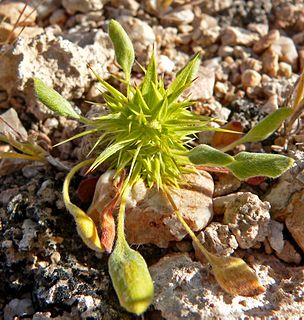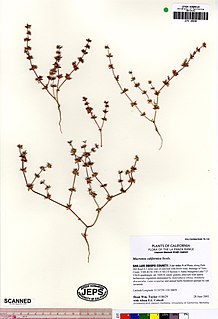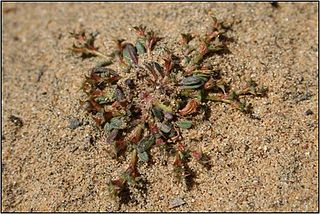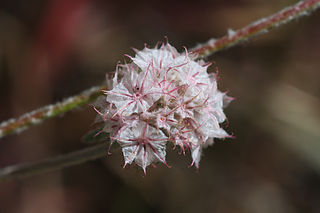| Chorizanthe valida | |
|---|---|
 | |
| Scientific classification | |
| Kingdom: | Plantae |
| (unranked): | Angiosperms |
| (unranked): | Eudicots |
| (unranked): | Core eudicots |
| Order: | Caryophyllales |
| Family: | Polygonaceae |
| Genus: | Chorizanthe |
| Species: | C. valida |
| Binomial name | |
| Chorizanthe valida S.Wats. | |
Chorizanthe valida is a rare species of flowering plant in the buckwheat family known by the common name Sonoma spineflower. It is endemic to West Marin, Marin County, California, where it is known from only one remaining natural population at Point Reyes National Seashore. It was thought to be extinct until 1980 when the Point Reyes population was discovered. [1]
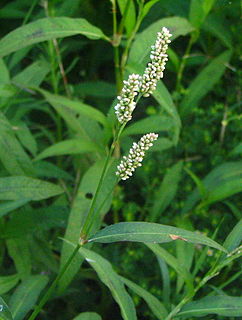
The Polygonaceae are a family of flowering plants known informally as the knotweed family or smartweed—buckwheat family in the United States. The name is based on the genus Polygonum, and was first used by Antoine Laurent de Jussieu in 1789 in his book, Genera Plantarum. The name refers to the many swollen nodes the stems of some species have. It is derived from Greek; poly means many and goni means knee or joint.

Endemism is the ecological state of a species being unique to a defined geographic location, such as an island, nation, country or other defined zone, or habitat type; organisms that are indigenous to a place are not endemic to it if they are also found elsewhere. The extreme opposite of endemism is cosmopolitan distribution. An alternative term for a species that is endemic is precinctive, which applies to species that are restricted to a defined geographical area.
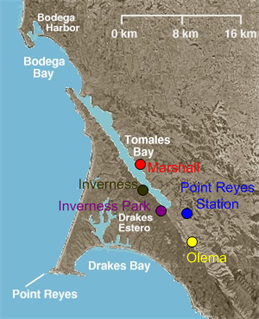
West Marin is the largest rural region of Marin County, California.
Contents
Chorizanthe valida is a federally listed endangered species.

An endangered species is a species which has been categorized as very likely to become extinct. Endangered (EN), as categorized by the International Union for Conservation of Nature (IUCN) Red List, is the second most severe conservation status for wild populations in the IUCN's schema after Critically Endangered (CR).
This plant is erect in form, reaching up to about 30 centimeters tall. The inflorescence is a cluster of flowers with each flower surrounded by six reddish or gray bracts, each tipped with a straight awn. The awns are bright red when new and age ivory white. [2] They are not hard or hooked in shape like those of many other Chorizanthe. [3] The flower is a few millimeters long and white or pink in color.

An inflorescence is a group or cluster of flowers arranged on a stem that is composed of a main branch or a complicated arrangement of branches. Morphologically, it is the modified part of the shoot of seed plants where flowers are formed. The modifications can involve the length and the nature of the internodes and the phyllotaxis, as well as variations in the proportions, compressions, swellings, adnations, connations and reduction of main and secondary axes. Inflorescence can also be defined as the reproductive portion of a plant that bears a cluster of flowers in a specific pattern.

In botany, a bract is a modified or specialized leaf, especially one associated with a reproductive structure such as a flower, inflorescence axis or cone scale. Bracts are often different from foliage leaves. They may be smaller, larger, or of a different color, shape, or texture. Typically, they also look different from the parts of the flower, such as the petals or sepals. The state of having bracts is referred to as bracteate or bracteolate, and conversely the state of lacking them is referred to as ebracteate and ebracteolate, without bracts.

Ivory is an off-white color that resembles ivory, the material from which the teeth and tusks of animals is made. It has a very slight tint of yellow.

This rare plant once had a wider distribution; specimens were collected many decades ago in neighboring Sonoma County. [3] Today it is limited to Point Reyes where there is one natural population at Abbotts Lagoon and one that has been reintroduced by humans near Bull Point. [3] The number of individuals is variable. [3]

Sonoma County is a county in the U.S. state of California. As of the 2010 United States Census, its population was 483,878. Its county seat and largest city is Santa Rosa. It is to the north of Marin County and the south of Mendocino County. It is west of Napa County and Lake County.

Abbotts Lagoon is a two-stage lagoon on the northwestern coast of the Point Reyes National Seashore, southwest of Tomales Point. The upper lagoon is a fresh water impoundment which overflows into a lower brackish level with occasional winter tidal exchange. The eastern shore of the lagoon is covered with old growth northern coastal scrub including coyote bush, yellow bush lupine, sword fern and California blackberry.
The local habitat is coastal prairie on deep, sandy soils. [3] The soil, remnants of a Pleistocene dune system, can bear only drought-tolerant plants because it cannot retain much water. [3]

California coastal prairie, also known as northern coastal grassland, is a grassland plant community of California and Oregon in the temperate grasslands, savannas, and shrublands biome. It is found along the Pacific Coast, from as far south as Los Angeles in Southern California up into southern Oregon.
The Pleistocene is the geological epoch which lasted from about 2,588,000 to 11,700 years ago, spanning the world's most recent period of repeated glaciations. The end of the Pleistocene corresponds with the end of the last glacial period and also with the end of the Paleolithic age used in archaeology.

In physical geography, a dune is a hill of loose sand built by aeolian processes (wind) or the flow of water. Dunes occur in different shapes and sizes, formed by interaction with the flow of air or water. Most kinds of dunes are longer on the stoss (upflow) side, where the sand is pushed up the dune, and have a shorter "slip face" in the lee side. The valley or trough between dunes is called a slack. A "dune field" or erg is an area covered by extensive dunes.
Research suggests that areas with grazing cattle contain a larger number of plants than areas where animals are excluded, but the plants in the exclusion areas are larger and have more flowers. [3] [4] Cattle do not eat the rare plant and may in fact help clear the land of invasive non-native plants, such as velvetgrass (Holcus lanatus). [3] The land around Abbotts Lagoon is a cattle pasture today. [3]

Grazing is a method of feeding in which a herbivore feeds on plants such as grasses, or other multicellular organisms such as algae. In agriculture, grazing is one method used whereby domestic livestock are used to convert grass and other forage into meat, milk and other products.

Cattle—colloquially cows—are the most common type of large domesticated ungulates. They are a prominent modern member of the subfamily Bovinae, are the most widespread species of the genus Bos, and are most commonly classified collectively as Bos taurus.

An invasive species is a species that is not native to a specific location, and that has a tendency to spread to a degree believed to cause damage to the environment, human economy or human health.
This species occurs within the bounds of a protected National Seashore, so its habitat will not be developed, and it is protected from such activities as mining, dredging, and horseback riding activity. [3] Threats that do remain include damage by hikers and off-road vehicles. [3] The overall effects of cattle on the land are not certain; they may actually be a positive force in the life of the rare plant. [3] The plant is limited to two relatively small populations, so any one severe event such as wildfire or drought could drive it to extinction. [3] [5]

